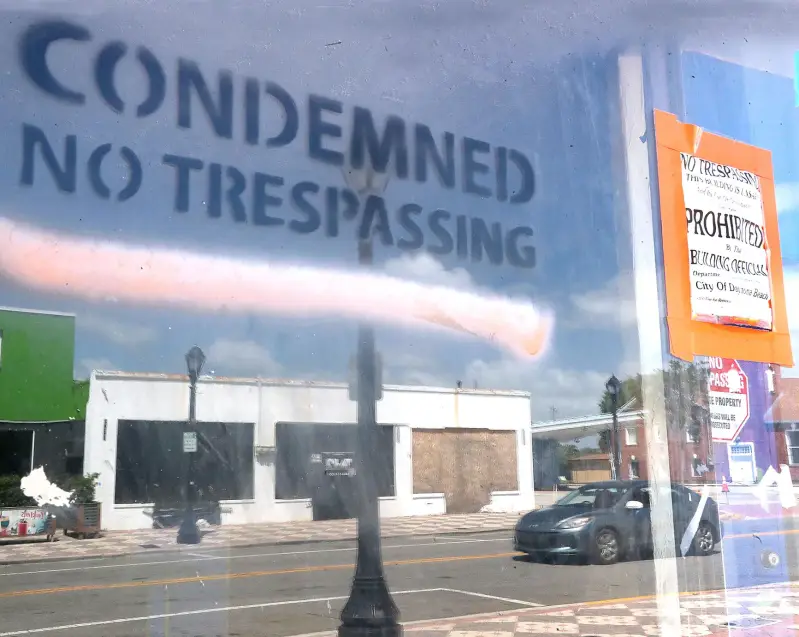
Volusia County, FL — November 2025
Florida’s beachside communities are facing a growing crisis as the number of condemned buildings continues to rise, sparking concern among local business owners, residents, and preservation advocates. From Daytona Beach to Bradenton Beach, aging structures—many with deep historical and architectural significance—are being red-tagged for demolition due to structural concerns, code violations, and the financial strain of new safety regulations. The trend is not only reshaping the skyline but threatening the cultural and economic fabric of these coastal towns.
🏚️ A Surge in Condemnation Notices
In recent months, dozens of buildings along Florida’s beachside corridors have received condemnation notices, citing issues ranging from foundation instability and roof collapse to outdated electrical systems and water damage. Many of these structures date back to the mid-20th century, built during the post-war boom that defined Florida’s coastal charm. While some buildings are clearly unsafe, others are caught in a gray zone—technically out of compliance but still structurally sound enough to be restored.
The uptick in condemnations is partly driven by Florida’s updated condo safety laws, passed in response to the 2021 Surfside tragedy. These laws require milestone inspections and reserve studies for buildings over 30 years old, with strict deadlines and costly compliance requirements. For small property owners and condo associations, the financial burden can be overwhelming.
📉 Economic Ripple Effects
Business owners say the visual and economic impact is already being felt. “We’ve lost three neighboring storefronts in the last six months,” said a boutique owner near Daytona’s beachside strip. “They were forced to close when their buildings were condemned. Now we’re seeing fewer tourists, less foot traffic, and more uncertainty.”
Restaurants, surf shops, and family-run motels—many of which operate in older buildings—are especially vulnerable. With fewer options for affordable renovation loans, some owners are choosing to shut down rather than fight a losing battle with code enforcement.
🏛️ Preservation vs. Progress
Preservationists argue that many of these buildings are worth saving. “These aren’t just structures—they’re part of our coastal identity,” said a spokesperson for the Florida Historic Coastal Trust. “We need to invest in adaptive reuse and restoration, not demolition.”
Advocates are pushing for state and local governments to offer grants, tax incentives, and technical support for property owners willing to preserve historic buildings. Some municipalities, like St. Augustine and Sarasota, have launched pilot programs to help owners navigate the inspection process and access funding for repairs.
🧱 The Human Toll
For residents, the issue goes beyond economics. “My family has lived in our building for 22 years,” said one Daytona Beach resident whose apartment complex was recently condemned. “We were given 30 days to vacate. It’s heartbreaking—and we don’t know where to go.”
Many displaced residents are low-income families, retirees, and seasonal workers who rely on affordable housing near the beach. With limited options and rising rents, some are turning to shelters or leaving the area entirely.
⚖️ Regulatory Pressure and Delays
Statewide, fewer than half of the buildings required to submit inspection reports have done so, according to recent data. The backlog is creating confusion and delays, with some cities forced to act preemptively to avoid liability. Meanwhile, insurance premiums and maintenance costs are rising, making it harder for small associations to stay afloat.
Local officials say they’re caught between enforcing safety and preserving community. “We don’t want to tear down our history,” said one city commissioner. “But we also can’t ignore the risks. We need more tools to help owners bring their buildings up to code.”
🌅 A Call for Action
As Florida’s beachside communities grapple with this growing challenge, stakeholders are calling for a balanced approach—one that prioritizes safety without sacrificing heritage. Business owners, residents, and preservationists are urging lawmakers to revisit the implementation timeline of the condo laws and expand funding for restoration efforts.
Without intervention, the red tags will keep multiplying—and the character of Florida’s beachside may be lost to the wrecking ball.
Sources:
-
WFLA – Bradenton Beach Condemnation Notices
-
Palm Beach Post – Florida’s Condo Crisis
-
WLRN – Condo Inspection Backlog
-
CBS12 – Rising Costs from New Laws
Add comment
Comments